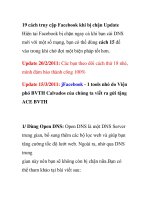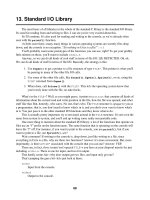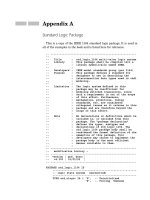End user standard update
Bạn đang xem bản rút gọn của tài liệu. Xem và tải ngay bản đầy đủ của tài liệu tại đây (926.39 KB, 72 trang )
23
KRONE
Standard Update Training
Singapore
29 – 31 July 2002
Instructor: Anton Indrawata
KRONE
KRONE
Standard Update Training
Standard Update Training
Singapore
Singapore
29
29
–
–
31 July 2002
31 July 2002
Instructor: Anton
Instructor: Anton
Indrawata
Indrawata
23
Standards Framework
Mandatory
z Local Authority Technical Standards:
z Cable and cabling components (Permit or CCL required)
z Wiring Practices (particularly separations/segregation's)
Industry Recommendations
z ISO/IEC 11801 & EIA/TIA 568 B : Structured Cabling Design,
dimensions, component specification, installation practices, compliance
testing, Class D or Cat.5E bandwidth up to100MHz, Class E or Cat. 6
bandwidth up to 250 MHz parameters.
z EIA/TIA 569A: Design and installation practices of cabling pathways,
spaces, support structures, termination, cross connect enclosures and
cable entrance facilities.
z EIA/TIA 606: Administration of communications cabling systems includes
plant symbols, cable records and component labeling.
23
Local Authority Compliance
Only licensed cable's install/maintain
Cable, cabling products and customer equipments must be either:
Labeled with local authority permit number, or
Listed in the Certified Components List ( CCL ), or
Labeled with the local authority symbol
All customer equipment shall exhibit Authority permits
23
Authority Technical Standards
Ensure a safe environment for:
z carrier’s personnel
z customer/user
z carrier’s equipment
and;
z interference-free operation for carrier’s equipment
z correct inter-working between carrier’s equipment and customer premises
equipment
23
Cabling Standardisation history
Cat 5
Cat 5E Cat 6, 7
Cat3
Cat4
=
TIA 568-BTIA/
EIA
TIA
568
TSB
36
TSB
40A
TIA
568A
TSB
67,72,75
TIA568A
Add 1-5
TIA
568B.2-1
+ = + ++
1,2,3
ISO
Class D New Class D
Class E, F
ISO
11801
Add 1-2
ISO
11801
Ed.2
ISO
11801
EN
50173
EN
50173
Add 1
1991 1995 1999 2001
CENELEC
EN
50173
Ed.2
2000 2002
23
ISO/IEC 11801 Standards history
The first and most important document in this series is ISO/IEC 11801
ISO/IEC 11801 – 1995: Generic Cabling for Customer Premises
z Defines performance of Category 5 / Class D of Basic and Channel Link
z Superseded by ISO/IEC 11801 2
nd
edition 2002
ISO/IEC 11801 AMENDMENT2- 1999
z Major update to ISO/IEC 11801 – 1995
z Adds requirements for new measurements, defines Permanent Link and
Channel
z Harmonized with EIA/TIA 568B Cat 5E
ISO/IEC 11801 2
nd
edition – 2002
z The 2
nd
edition incorporate specifications for Category 6 / Class E and
Category 7 / Class F cabling components
23
CENELEC Standards history
EN 50173 - 1995: Generic Cabling Standard for Customer Premises
z Specifies generic cabling for use within commercial premises
z Very similar to ISO 11801
z Amendment 1999 add permanent link and channel definitions as well as
new measurement parameters
EN 50173 – 2000 2
nd
edition
z To harmonize with ISO 11801 2
nd
edition and include specifications of
Category 6 / Class E and Category 7 / Class F cabling components
EN 50174-1-1999: Administration, documentation, records
z Describes requirements for administration system, documentation of
pathway, spaces, cables, terminations, grounding in accordance with EN
50173
23
North American Standards history
EIA/TIA 568A - 1995: Commercial Building Telecommunications Wiring
Standard
z Establishes technical and performance criteria for cabling system
configuration, interfacing and connecting hardware
EIA/TIA 568A-A1 – 1998: Delay & Delay Skew
z Defines and specifies requirement s for propagation delay and delay skew
in cables, components, basic link and channels
z Replaced by EIA/TIA 568B
TIA 568A-A2 – 1998: Miscellaneous Changes
z Requirement for testing connecting hardware with both common and
differential mode terminations
z Replaced by EIA/TIA 568B
23
North American Standards history
EIA/TIA 568A-A3 – 1998: Bundled and Hybrid Cables
z Defines and specifies requirement for testing of bundled and hybrid
cables
z Replaced by EIA/TIA 568B
EIA/TIA 568A-A4 – 1999: Patch Cords
z Defines and specifies NEXT and RL for patch cables
z Replaced by EIA/TIA 568B
EIA/TIA 568A-A5 – 1999: Additional Transmission Performance
Specifications for Enhanced Category 5 Cabling
z Provides performance requirements for Enhanced Category 5
components, cables and links; includes all the measurements in
TSB67 and TSB95, Replaced by EIA/TIA 568B
23
North American Standards history
EIA/TIA 568B.1 – 2000: Commercial Building Telecommunications
Wiring Standard
z This is a major standard release that updates and replaces: TSB67,
TSB72, TSB75, TSB95, TIA 568A and its addendum’s 1,2,3,4,5 and
TIA ScTP.
z Include Category 5E performance levels, 50/125um fiber
z Category 5E becomes the minimum accepted performance level
EIA/TIA 568-B.2: 100 Ohm Twisted Pair Cabling Standard
z Technical content 0n 100 Ohm twisted pair cabling referenced by TIA
568-B.1
EIA/TIA 568 – B.2-1: Category 6
z The draft 11
th
has been ratified and finalized in June 17,2002, the
most complete document providing Category 6 performance
23
North American Standards history
EIA/TIA 568-B.3: Optical Fibre Cabling Standard
z Technical content on optical fibre cabling that is referenced by EIA/TIA
568-B.1
EIA/TIA 568-B.4: Shielded Twisted Pair Cabling Standard
z Technical content on shielded twisted pair cabling that is referenced by
EIA/TIA 568-B.1
EIA/TIA 569A – 1995: Commercial Building Standard for
Telecommunications Pathways and Spaces
z Specifies design and construction of pathways and spaces, installation
practices for telecommunications services within and between commercial
buildings
EIA/TIA 570A – 1998: Residential and Light Commercial
Telecommunications Wiring Standard
z Specifies residential cabling systems, requirements and structure
23
North American Standards history
EIA/TIA 606 – 1994: Administration Standard for the
Telecommunications Infrastructure of Commercial Buildings
z Specifies administration of communications wiring and connecting
hardware, building distribution systems, grounding and bonding.
z Standardized labeling and documentation requirements for generic
cabling in commercial buildings
EIA/TIA TSB67 – 1995: Transmission Performance Specifications for
Field Testing of UTP Cabling Systems
z Defines the basic link and channel
z Specifies performance requirements for the basicl link and channel, wire
map, length, attenuation, NEXT.
z Defines field measurement procedures and test instruments requirements;
replaced by EIA/TIA 568B.
23
North American Standards history
EIA/TIA TSB95 – 1999: Additional Transmission Performance
Specification for UTP
z For Gigabit Ethernet: defines minimum test requirements for RL,
ELFEXT, Powersum ELFEXT, propagation delay and delay skew
z Replaced by EIA/TIA 568B
23
ANSI EIA/TIA 568-A Revision
568-B.1
Main document :
•Installation
•Link requirements
•Testing
568-B.2
100 ohm
UTP/FTP
568-B.3
FIBER
568-B.4
STP-A
Document :
•Cable
•Connector
•Link
•Model
568-A
+
TSB-67
TSB-72
TSB-75
TSB-95
23
CENELEC Standards history
EN 50173 - 1995: Generic Cabling Standard for Customer Premises
z Specifies generic cabling for use within commercial premises
z Very similar to ISO 11801
z Amendment 1999 add permanent link and channel definitions as well as
new measurement parameters
EN 50173 – 2000 2
nd
edition
z To harmonize with ISO 11801 2
nd
edition and include specifications of
Category 6 / Class E and Category 7 / Class F cabling components
EN 50174-1-1999: Administration, documentation, records
z Describes requirements for administration system, documentation of
pathway, spaces, cables, terminations, grounding in accordance with EN
50173
23
CENELEC Standards history
EN 50174-2-2000: Planning and installation practises
z Specifies requirements for planning, specification, quality, assurance and
installation of new balanced copper and optical fibre
EN 50174-3-1999: Installation, Planning and Practises External to
Buildings
z Details requirements and guidance for installation, planning and practises
for balanced copper and optical fibre external to buildings
EN 50346-2000: Procedure for Testing Premise Cabling
z Specifies procedures for testing the transmission performance of installed
cabling inpremises
z To be used for acceptance testing, verification, and trouble shooting of
faults
23
CENELEC Standards history
EN 50173 - 1995: Generic Cabling Standard for Customer Premises
z Specifies generic cabling for use within commercial premises
z Very similar to ISO 11801
z Amendment 1999 add permanent link and channel definitions as well as
new measurement parameters
EN 50173 – 2000 2
nd
edition
z To harmonize with ISO 11801 2
nd
edition and include specifications of
Category 6 / Class E and Category 7 / Class F cabling components
EN 50174-1-1999: Administration, documentation, records
z Describes requirements for administration system, documentation of
pathway, spaces, cables, terminations, grounding in accordance with EN
50173
23
EIA/TIA 569-A Overview
EIA/TIA 569 pays attention to:
z Pathway separation from electrically - noisy sources
z Securing practices
z Minimum bending radii and minimizing hauling tensions
z Design/installation of closets, enclosures, equipment room and lead-in
cable entrance facilities
z Pathway techniques:
z
catenaries
z
trays
z
ducting
z
down poles
23
Horizontal Pathways
Include underfloor ducts and cellular floor raceways
incorporated into the building’s concrete structure
Include conduit/tray/wireways under unlimited access
(raised flooring)
Include conduit/tray/catenary wire used above false
ceilings in conjunction with drop down facilities such as
using steel stud walls, utility poles and perimeter (wall)
ducting
23
Safety Installation Rules - 1
For customer cabling:
never share common ducting space or conduit space with hazardous
services.
completely separate compartments for LV and customer’s cabling in
shared ducting.
If no barrier: 50 mm minimum separation from LV power and customer
cabling.
With durable intervening barrier: no further separation required between
LV power and customer cabling
LV power crossing customer cabling without durable intervening barrier:
require min. 50 mm separation.
HV power cannot share common ducting space with customer cabling
23
Power Cabling Separations/Segregation's for
KRONE Compliance
Power Cable separation/segregation from Customer cabling
Power Cable Type
Parallel Runs Crossings
1. SELV, ELV
* no cable separation required
* no cable separation required
2. LV * 50 mm minimum with no intervening
barrier
* separation by durable insulation
barrier OR
protectively earthed any metallic
barrier
* separated by durable insulation barrier
made e.g. by galvanized steel, high impact –
PVC
3. HV
a. Single-core
b. Multi-core
* 450 mm minimum * 450 mm minimum
*
300 mm minimum
OR
* 150 mm minimum with durable
insulation barrier with 175 mm
sheath to sheath minimum distance
around the barrier
* 300 mm minimum
OR
* 150 mm minimum durable insulation
barrier with 175 mm sheath to sheath
minimum distance around the barrier
23
Power Separations/Segregation's for
KRONE Compliance
Interfering Circuit Power rating
KVA : ( V x I ) / 1000
Separation distance ( mm ) between
communications and power cabling
Unshielded Power
Cable
Shielded Power
Cable
Less than 1 50300
Greater than 1 but less than 2
Greater than 2 but less than 5
Greater than 5
450
600
1500
50
150
300
KRONE requires a minimum of 50 mm separation for safety
In addition, if the LV cable is totally metallically enclosed (metal compartment in ducting, for example)
and the metal earthed to the protective earth of the building, these separation distances are not
necessary. Aluminium does not shield against the magnetic field of current surges so ferrous ducting is
required for a relaxation in Table 1 rules
23
Minimum noise separation at right angle crossing
between LV power & communications cabling
LV power cable
D mm = minimum separation
Communications Cable
D = (T - L) mm
L mm
LV power cable
L mm
Communications Cable
23
Safety Installation Rules – 1( continued )
For customer cabling:
HV power to customer cabling min. separation:
Without intervening barrier: 450 mm for multi-core HV power cable and
300 mm for single-core HV power cable.
With intervening barrier: min. 150 mm
23
Safety Installation Rules - 2
Power and customer cabling terminations
z HV power cable: separate enclosure and 450 mm separation
z LV power cable: may share common enclosure if durable intervening
barrier provided ( must be earthed if metallic ) or 50 mm separation.
ELV ( Data & Security ) and customer cabling
z Cable separation is not required; can share common ducting
z Durable barrier required between terminations









